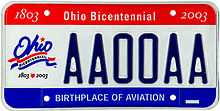Ohio Bicentennial


The Ohio Bicentennial was a series of events and programs held in the U.S. state of Ohio to coincide with the 200th anniversary of statehood on March 1, 2003. The Ohio Bicentennial Commission was established by the Ohio General Assembly in 1995 to sponsor commemorative barn paintings, bells, and historical markers throughout the state in the years leading up to the celebration.[1]
Complementing the Commission's programs, the Ohio Historical Society restored the Adena Mansion, originally the home of Thomas Worthington, in 2003.[2] In 2002, the U.S. Mint released 632,032,000 quarters commemorating Ohio's bicentennial as part of its 50 State Quarters program.[3]
Statewide commemorations
From 1997 to September 2002,[2] the Committee commissioned Scott Hagan of Belmont County to paint a barn in each county with the committee's logo and colors. Nearly 2,000 barn owners volunteered their barns to be painted.[4] In the end, Hagan painted 101 barns freehand, including one in each county.[5] One was destroyed by a tornado shortly after its painting and was replaced.[2][6] The barn painting program was conceived as a cost-effective way to advertise: each barn cost $1,500 to paint, about $500 less than the rent for a billboard. The painted barns celebrated the state's 200th anniversary in 2003. By 2013, many of the painted barns had faded or been repainted or torn down.[7] Hagan went on to paint barn advertisements across the country.[8]
The Commission also commissioned The Verdin Company of Cincinnati to cast a bronze bell on site, out in the open, in each county throughout the bicentennial year.[9] Each 25-pound (11 kg) bell took two days to cast using a mobile foundry.[10]
During the summer of 2003, a wagon train traveled across the state on the historic National Road from Martins Ferry to the Indiana state line at New Paris.[11]
License plate

The Ohio Bureau of Motor Vehicles also issued a radical redesign of the state's license plate that bore the Commission's logo to the left, the words "1803 Ohio Bicentennial 2003" across the top, and a new six-digit numbering scheme. Previously, commemorative license plates had been issued for the state's sesquicentennial in 1953 and for the Northwest Territory's sesquicentennial in 1938.
References
- ↑ "Ohio's Bicentennial Celebration Frequently Asked Questions". Ohio Bicentennial Commission. 2003. Archived from the original on December 2, 2003.
- ↑ 2.0 2.1 2.2 "Ohio's Bicentennial". Ohio History Central. Ohio Historical Society. May 23, 2013. Retrieved September 8, 2013.
- ↑ "Ohio Quarter Debuts Today". Orlando Sentinel (Tribune Publishing). March 11, 2002. Retrieved January 1, 2015.
- ↑ "Bicentennial Barns Project: General Information". Ohio Bicentennial Commission. 2003. Archived from the original on December 2, 2003.
- ↑ MacCarter, Mike (December 27, 2007). "Ohio Bicentennial Barns". Ohio Barns. Retrieved April 6, 2011.
- ↑ MacCarter, Mike (July 1, 2009). "Ottawa Co". Ohio Barns. Retrieved April 6, 2011.
- ↑ "Some Ohio Bicentennial Logos In Barns Are Fading". WBNS-TV. Associated Press. August 11, 2013. Retrieved September 8, 2013.
- ↑ Suchetka, Diane (June 27, 2011). "Ohio bicentennial barn painter Scott Hagan: Whatever happened to ...?". The Plain Dealer (Advance Publications). Retrieved September 8, 2013.
- ↑ "Bicentennial Bells Project: General Information". Ohio Bicentennial Commission. 2003. Archived from the original on December 6, 2003.
- ↑ ""Foundry on wheels" casts bicentennial bells in Ohio counties". Modern Casting (Des Plaines, Illinois: American Foundry Society) 92 (10): 14. October 2002. ISSN 0026-7562. Retrieved January 1, 2015. (subscription required (help)).
- ↑ Longfellow, Rickie (April 7, 2011). "Ohio Celebrates Bicentennial-1803-2003". Federal Highway Administration. Retrieved September 8, 2013.
Further reading
- Wilkinson, Christina (January 1, 2003). Bicentennial Barns of Ohio: A Tribute to the Barns and Their Owners. Rosewood Press. ISBN 0974202002. A history of the bicentennial barns licensed by the Bicentennial Commission.
External links
| Wikimedia Commons has media related to Ohio Bicentennial. |
- Ohio Bicentennial Commission at the Wayback Machine (archived December 24, 2003)
- Ohio Bicentennial Barns – photos and addresses of Bicentennial Barns
- The Barn Artist – website of the Bicentennial Barn artist